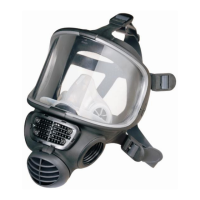14
5.8 Cleaning
Remove the filter/filters, valves, spectacle frame, speech diaphragm and inner mask. Also
eventual breathing hose.
Clean the facepiece and components with a damp cloth or sponge, using lukewarm water
and mild detergent (neutral, pH 6-8) (e.g. washing-up liquid). A brush can be used for
stubborn dirt (be careful not to scratch the visor).
Do not use solvents (e.g. alcohol, acetone, turpentine), hot water or bleaching agents
(perborate, percarbonate).
5.9 Disinfection
After cleaning, disinfect the inside/faceseal with a disinfection solution (e.g. Scott Trigene),
rinse and allow to dry. Finally, reassemble the mask.
5.10 Storage
Storage protected from direct sunlight, at -10...+50 °C and relative humidity (RH) under 75
% (sealed filters RH max. 95 %). A properly stored, unused mask stays in good condition
for a long storage period.
The components should not be more than 12 years old.
Before use, the mask must undergo a function test, see Table.
After use, an opened filter must be sealed tightly if it is to be reused, but it must be
replaced within 6 months at the latest.
5.11 Disposal
Masks (without filters) are coarse waste. A very contaminated mask as well as used filters
are special refuse and shall be disposed of according to the filtered substances (gases or
particles).
5.12 Australia and New Zealand
For complete national requirements, please refer to the standard AS/NZS1715:2009, Use &
Maintenance of Respiratory Products.
Cleaning
Disinfection
Test for function and leak-tightness/Pro-Tester
Pre-use check done by the user, according to
point 4
Replace: visor, head harness, buckles, inner
mask and other parts
Check
Replace
Check tightness of exh. valve disc/Pro-Tester
Check valve seat (part 6a)
*) when needed
Scott Health & Safety Oy
P.O.BOX 501
FI-65101 Vaasa, Finland
TECHNICAL SUPPORT & SALES
Tel. +358 (0)6 3244 543 or 544 or
535 Fax +358 (0)6 3244 591
www.scotthealthsafety.com

